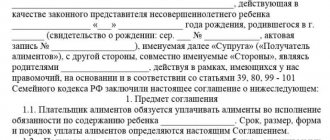Creditors are interested in collecting debt and use all legal instruments to do this. One of the most effective is considered to be subsidiary liability - this is the liability of third parties who are obliged to pay the debt if the main debtor is unable to do so. The grounds for bringing to subsidiary liability are fixed in the law. The interpretation of what subsidiary liability is lies in the term itself. Susidiarus is translated from Latin as reserve or auxiliary. Often, guarantors, company managers or controlling persons do not even suspect that they are exposed to high financial and legal risk. However, ignorance of the law or inattention to detail has never freed one from negative consequences. Legal provides qualified legal assistance to those who bear subsidiary liability and those who intend to return their money.
What is a subsidy?
If the opportunity to resolve the issue with the main borrower has been exhausted, claims are presented to subsidiary debtors, since this format of additional civil liability is enshrined in the Civil Code of the Russian Federation. That is, subsidiary is a common name for reserve liability in a narrow environment. Anyone can face it, from the director of a company that has become bankrupt, to the parents of a young boy who broke someone else’s window with a ball, but does not have the means to replace it. In both cases, the unifying aspect is the obligation to compensate, to pay the amount for another person. If a conflict in the yard can be resolved quite simply, then at the business level it is impossible to do without competent legal support, especially when it comes to financial insolvency due to the fault of managers. Lawyers at Yuridicheskaya perfectly know the subsidiary procedure and the intricacies of such legal relations, therefore they are ready to get involved at any stage and provide comprehensive protection.
For what? The need for a guarantee
For a bank, a guarantee agreement is an opportunity to reduce the risk of loan non-repayment.
Let’s look at why the borrower needs this below.
If you do not have enough income to receive a particularly large amount from the bank, the credit institution has the right to require you to hire a person who is ready to vouch for you if it suddenly turns out that you have overestimated your ability to pay monthly payments.
Some credit institutions can thus reduce the interest rate on the loan, because the lower the risk of non-repayment of the debt, the higher the bank’s loyalty to the borrower.
The bank may also require the involvement of a guarantor to additionally secure the loan agreement in cases where the main borrower has had problems in the past with repaying previous loans.
Types of subsidiary liability
An auxiliary measure to ensure the interests of creditors can come from an agreement or law. That is, the main types are contractual and non-contractual. In accordance with the terms of the agreement, obligations are transferred to the subsidiary debtor, regardless of the fact of his guilt in the delay, provided that the main borrower has not fulfilled the obligations. As a general rule, his liability is joint and several, and only if there is a special provision in the contract does it become subsidiary. Thus, political parties are responsible for the activities of their cells and regional offices. Vicarious liability of shareholders occurs if their actions or inactions led to the bankruptcy of the company. The second type is also called statutory. Legal support will allow you to analyze the documents and legal status of the subject, assess the extent and nature of obligations, balance the consequences and develop the right strategy for protecting interests.
Solidarity debt collection in practice
As mentioned above, joint and several liability occurs in the presence of an appropriate agreement. For example, this could be a guarantee agreement, under which the guarantor is equally liable with the borrower for the debts of the latter. Below we will consider law enforcement practice in such cases.
Joint and several liability is also provided for in the founding agreement of a general partnership. Moreover, the founders are liable with their personal property.
As for the indivisibility of the subject of the obligation, this aspect is revealed in Article 133 of the Civil Code of the Russian Federation. Indivisible is a thing that is destroyed, damaged or changes its properties during division and can no longer be used for its original purpose.
Various services are considered as indivisible obligations. For example, two construction companies jointly acted as a contractor, but did not build and equip the facility on time.
They will be responsible to the customer together, even if one of the companies has fulfilled its obligations. The justification for this decision is Art. 311 of the Civil Code of the Russian Federation, according to which such services must be provided as a one-time act, and in full.
The joint and several procedure for debt collection is provided for insurance companies that jointly insured one object and did not divide their responsibilities in the contract.
If harm is caused as a result of the interaction of two or more sources of increased danger, for example, cars, their owners are liable jointly. Also, a victim in an accident has the right to demand compensation for damage from both the driver who caused the accident and the insurance company (OSAGO).
Who is considered to be the person controlling the debtor?
In practice, subsidiary liability of controlling persons is common. These are entities that, for three years before the bankruptcy of the company, as well as directly during the arbitration proceedings, had the right to give binding instructions and orders. That is, such a legal entity or individual had the direct ability to manage actions, control transactions and the conditions for their completion. The head of the debtor is also a controlling person, unless otherwise proven in court. A similar status is vested in the liquidator, members of the liquidation commission, the executive body of the debtor or its management organization. In this case, two conditions must be met. Such an entity benefited from illegal or dishonest actions of members of the executive body, and also had the opportunity, independently or jointly with other participants, to dispose of 51% or more of the capital or voting shares of the company.
Features of joint claims
Not only obligations are joint and several, but also claims, for example, from a group of creditors. Each of them has the right, separately from the others, to demand that the borrower repay the debt in full.
If there is no such requirement, the debtor can pay the debt to any of the creditors. If the debt is paid in full, then the debtor no longer has obligations to other solidary creditors.
The creditor to whom the debt was paid must, in turn, distribute the amount received in equal or contractually determined shares among his partners.
In cases specified by law, debt repayment is permitted through the court or through a notary, to whose deposit the required amount is transferred.
When does subsidiary liability arise for a CDL?
The lack of the debtor's assets to cover all the creditors' claims makes it possible to foreclose on unscrupulous managers and compensate the debt at their expense. Grounds for subsidiary liability of controlling persons:
- untimely initiation of bankruptcy proceedings;
- proof of the status of a controlling person influencing the company’s decisions;
- claims of the authorized body exceeding half of the total claims of all third-priority creditors;
- proven dishonesty of the company's actions, which led to exceeding the limits of acceptable business risks and, as a result, to bankruptcy;
- unfulfilled obligations to transfer reports, accounting documents, or prepared fictitious documentation.
It is important for the person controlling the debtor to understand what subsidiary liability means, to build a competent evidence base and to refute each point of accusation. Creditors can make claims against such entities even when the company has already been declared bankrupt and the process of selling the property has been completed. A qualified lawyer will quickly navigate the situation and develop the necessary strategy.
What actions of the CDL lead to a subsidy?
Vicarious liability for the controlling debtor of the person arises if he has not entered information into the Unified State Register of Legal Entities and into the federal resource at the time when a criminal bankruptcy case has already been initiated. The absence of accounting documents or the information they contain, as well as their falsification and distortion, are considered a violation. A situation where subsidiary liability arises is considered to be a violation by the controlling person of the rules for storing documents if, in accordance with the legislation on joint-stock companies, investment funds, and the securities market, they must be present at the time the person is declared bankrupt or supervision is introduced. The basis is also the totality of claims of third-priority creditors, if they arose as a result of the fact that the CDL or the debtor himself violated the law, therefore, at the time of closing the general register, the claims exceed half of the total amount claimed by third-priority creditors.
How is the amount of subsidiary liability determined?
The person controlling the debtor bears a subsidiary obligation in an amount equal to the total amount of all claims of creditors, provided that they are included in the relevant register at the time of bankruptcy and remain outstanding. In addition, current payments that are not repaid due to the fact that the debtor does not have funds are added to this amount. If it is proven that the amount of actual damage caused is significantly less than the amount presented, it will be reduced by the court. In accordance with the Civil Code of the Russian Federation, subsidiary liability is determined without taking into account the amounts required by the controlling person himself or persons interested and close to him. If all claims of creditors cannot be paid due to the actions or inactions of several controlling persons, such participants jointly and severally bear subsidiary liability. The participation of a lawyer will help protect against unfounded claims and minimize financial risks.
In what cases is the case considered in a simplified form?
Judges can consider a case in a simplified manner only in certain situations. To do this, certain conditions must be met.
- The amount of debt should not exceed 50 thousand rubles. This is prescribed by Article 23 of the Code of Civil Procedure of Russia.
- There is a need for an urgent decision. This is stated in Article 122 of the Code of Civil Procedure of Russia. The content of Article 122 was changed in June 2017. At the moment, a simplified collection procedure can be followed if there are debts for utility services. Owners and tenants of the home can be called upon to pay the debt.
Court orders are issued in cases where:
- The requirements are based on a contract certified by a lawyer;
- The agreement has written confirmation in the form of a document certified by a notary.
- Utility or housing debts, or debt for telephone services are collected from the debtor.
Banks can collect debts using an even simpler algorithm. Credit debts are collected from debtors without holding meetings. To collect this debt, a banking organization does not have to go to court. For credit debts, enforcement documents are issued. The bailiff service is based precisely on these documents. Court orders issued in a simplified form can also be easily challenged. The defendant may object to the plaintiff, or deny the legality of the decision. To challenge a court decision, the defendant only needs to submit an application to the district or city branch of the court.
Release from liability
A subsidiary obligation is an additional obligation. It does not apply to the person controlling the debtor if:
- the actions fully complied with the standard conditions of civil transactions;
- there was a conscientious attitude, diligence, reasonableness and expediency of actions;
- there are no violations of the property rights of creditors;
- it has been proven that the behavioral line of the controlling person was aimed at preventing significant harm and even greater damage to creditors.
Given the presumption of guilt, the burden of proof rests entirely with the secondary defendant. This is a difficult task. Legal offers professional legal support to prevent negative consequences for owners, managers, and business officials. Our scope of competence also includes subsidiary liability of individual entrepreneurs. The grounds for exemption are exhaustive and formulated in very abstract terms. The situation is complicated by the aggressive policy of the tax service, which proposes to check the financial sources of not only company managers, but also their family members, relatives, and colleagues.
How? List of documents required for participation
The guarantor who has decided to take such a responsible step must submit documents to the bank according to the same list as the title borrower:
- confirmation of official employment. A copy of the employment contract, an extract from the work record book or its certified copy indicating the position held and work experience will be suitable;
- certificate of income in the form of a bank or in the form of a standard 2-NDFL form, certified by the seal of the employing organization and the signature of its head. The certificate must reflect income for 6 months or more;
- if the male borrower has not reached the age of 27, then a document confirming the existence of a deferment from military service (registration certificate, military ID, etc.) is required.
How do subsidiaries and joint liability relate?
These two concepts are often confused and mistakenly identified. The difference between joint and subsidiary liability lies in the nature of the obligations. In the first case, the claimant himself determines which of the joint defendants to submit claims to and to what extent. In fact, there is no legal difference - whoever can, covers the debts. Often in practice it looks like one person is responsible for everyone and incurs large losses. In the second case, there are specific entities that will pay for the obligations of the main debtor only if he cannot do this on his own and, in parallel, there are legal grounds for filing claims against the subsidiary debtor. With joint and several liability, the subject of the obligations cannot be divided: they are not performed jointly, and the damage is caused in the same way. The law provides that the same persons can bear obligations jointly and subsidiarily at the same time. An example is the shareholders of a company convicted of leading to bankruptcy.
What decision can the court make?
The court considers cases when:
- The amount of debt is more than 50 thousand rubles.
- Several applications were filed in court at once. One of these applications must be considered by a city or district court.
The court may also reverse its previous decision at the request of the defendant. After reviewing the case materials, the court must pass a sentence, which will take effect after ten days. If the court sentences the debtor to pay the debt, then a writ of execution must be drawn up. If the sentence has already taken effect, it will be more difficult to cancel it. To appeal, you need to contact a higher judicial organization.
Several documents can be drawn up against debtors at once. The number of enforcement documents must also correspond to the number of debtors. Each execution document must contain the total amount of debt and personal data of each individual or legal entity.
The group of claims must immediately be combined into one consolidated writ of execution. If the plaintiff wants to achieve a positive result in a short period of time, then he needs to contact the main regional bailiff. Depending on the type of settlement, the application must be submitted to the regional, regional or republican FSSP center. The results of the trial and a petition for execution of the sentence must be sent to the local bailiff service. The management of the bailiff service will decide on its own which of its employees to entrust with the consideration of the case. After three days the execution of sentences is carried out. All defendants are notified by special notifications. The notice usually indicates the time during which the defendant can independently fulfill the obligation.
If the debt is not paid, the bailiff will begin enforcement proceedings. First of all, the debtor's account and property are seized. If the time allotted for voluntary repayment has expired, the bailiff seizes the debtor’s money and property. The money is collected from the official income of the debtor. The entire amount is transferred to close the debt. If necessary, the bailiff can also seize the debtor’s personal property. An enforcement lawyer can challenge the actions of the bailiff.
The law does not specify from which debtor the debt must be collected. There are also no instructions on how to distribute the amount of debt among debtors. The debt is usually written off from the person who is most solvent or from both debtors through personal bankruptcy proceedings. When collecting money, bailiffs pay attention to the following factors.
- How does a debtor relate to voluntary repayment of debt?
- The amount of money, the level of income of the debtor.
- Is it possible to defer debt repayment?
- In what region does the debtor live? If one of the defendants fulfills all legal obligations, then the forced collection will stop. If the performance activity was initially carried out in relation to one defendant, then all other parties to the contract are notified of the termination of the performance activity. Otherwise, the entire amount collected may be considered illegal receipt of money.
List of required documents
To go to court, you need to take with you:
- Lawsuit.
- A receipt confirming payment of the state duty.
- Identity documents.
- The representative must bring a power of attorney and his own passport.
- A document that proves the existence of debt and group liability of the mentioned persons.
- Document proving other relevant facts.
It is necessary to make copies of all listed documents. In court, the plaintiff must independently notify the defendants of the case initiated against them.
What conditions must be met to organize legal proceedings?
- A writ of execution or a court order is required.
- A completed application for organization of production is required.
- It is necessary to have documents confirming the ownership and property of the defendants.
- The plaintiff must bring with him a document confirming his identity.
- If this operation is performed by a trusted person, then a passport of the legal representative and a power of attorney are required.
Conclusion
It is not that difficult to collect joint and several liability from a group of persons. Any unprepared person can do this. However, all collection rules must be taken into account. If you do not pay attention to some aspects of group recovery, you may encounter a number of difficulties. If the concluded agreement indicated something that is not entirely clear, it is still better to contact a debt collection lawyer. After all, a quality lawyer can explain to his client many of the intricacies of legal procedures and help him avoid problems.
Sign up for a consultation
Procedure for bringing to justice
The person controlling the debtor, who is brought to subsidiary liability, is given the status of a procedural defendant. This allows, with a competent approach, to take advantage of the wide possibilities of defense in court. At this stage it is important to provide professional support and representation. Legal's lawyers have significant experience in successfully handling such cases. Vicarious liability of the participants means that the arbitration court has received an application. The CDL has the right to draw up a review and present its reasoning. The outcome of the trial largely depends on its content. Each argument must be supported by evidence. Preparation includes the development of a behavior strategy, collection and legal analysis of documentation, and assessment of the current situation. The line of defense is built on an individual basis, including taking into account the anti-crisis plan and the management hierarchy in a particular company. An option is being considered where shareholders jointly and severally bear subsidiary liability. It is important to remember that what is at stake is not just the financial component, but also the business reputation.
Who? Persons who can act as guarantors
Any individual can act as a guarantor, but it is worth remembering that his credit history will be studied as carefully as that of the main borrower.
The following information may also be specified:
- wage level;
- presence of Russian citizenship;
- work experience;
- having a criminal record;
- debts in other credit institutions;
- approaching retirement age.
There were even cases when the bank refused only for the reason that the borrower and the guarantor worked in the same company with a small number of employees.
The security service considered that if a crisis situation occurred, there was a high risk of dismissal of both employees.
If you decide to act as a guarantor for a loan, it is important to remember that all information on the loan will be transferred to the credit history bureau, where the status of its participation in the loan will be indicated.
This may result in the guarantor being denied credit due to the fact that he or she is a current guarantor of your loan.
Advice for potential subsidiary debtors
Preventing negative legal consequences is always cheaper than incurring subsidiary liability. In this aspect it is important:
- provide legal support and purity of transactions;
- conduct legal analysis of contracts and documents;
- prepare reporting and accounting documentation in a timely manner;
- conduct financial audit and legal analysis of activities;
- quickly restore lost and damaged documents;
- initiate bankruptcy proceedings without delay if there are compelling reasons for this;
- take a responsible approach to choosing contractors and partners;
- improve personnel management.
Most of these points can be resolved by timely involvement of qualified lawyers through outsourcing. Vicarious liability of legal entities and officials is associated with material risks and serves as a direct threat to the business reputation of both debtors and creditors. Legal offers comprehensive support and the full range of legal issues. A business must have a reliable legal foundation, and we provide it!
Solidary obligation with passive and active plurality
A joint and several obligation with passive plurality is a joint obligation or liability of joint debtors (Articles 322 - 325 of the Civil Code). The regime of joint and several passive plurality guarantees the interests of the creditor, since it provides him with the opportunity to make a claim simultaneously against all debtors or any of them, both in the full amount and in another amount at the choice and desire of the creditor himself.
A joint and several obligation with active plurality is a joint and several claim of joint and several creditors (Articles 322, 326 of the Civil Code). See more details “Solidary claim of creditors”
First to the borrower, then to the guarantor?
The creditor has the right to make a claim both against all solidary debtors jointly and against any of them, both in full of the obligation and in any part of it. Having not received full satisfaction from one of the joint and several debtors, he has the right, according to the same rules, to demand what was not received from the others, who remain responsible to him until his demands are fully satisfied.
These provisions are not controversial in judicial practice.
At the same time, in a number of cases, a dispute arises between the parties about the application of the provisions of Articles 322, 323 of the Civil Code of the Russian Federation, in particular, about the order of submission of claims for the collection of debt on a loan: for example, one of the parties believes that such claims should first be presented to to the borrower, and only then to the guarantors.
On the inconsistency of such a position, let us give an example of the arguments of the court, which considered a civil dispute:
“..Solidary obligations arise when several persons act on the side of the debtor and are jointly liable to the creditor. The creditor has the right to make claims against joint and several debtors in any sequence, against any of them or all at once (Article 323 of the Civil Code of the Russian Federation). In this case, the creditor is not required to justify his choice. The motives for filing a claim against any of the joint and several debtors or all of them at once may be different - more convenient jurisdiction, the most adequate property status of the selected debtor, or any personal relationship between the creditor and the selected debtor. The creditor has the right to distribute claims in a different manner. Due to joint liability, each of several debtors must satisfy the creditor's claim in full, but this satisfaction, made by one, frees all.
This legal structure best suits the interests of the creditor, because he has the right to make demands against the debtor who has more realistic opportunities to fulfill the obligation (bear responsibility) than the other joint debtors.
Taking into account the above, the appellant’s arguments about the order of presentation of demands for collection of loan debt: first to the borrower, and only then to the guarantors, are incorrect. Guarantors, by virtue of the provisions of Art. Art. 361, 363 of the Civil Code of the Russian Federation must be liable to the creditor jointly and severally with the debtor Suvar LLC, which presupposes the right of the creditor to apply for execution both to any of the joint debtors and to all debtors simultaneously” (extract from the appeal ruling of the Supreme Court of the Chuvash Republic dated September 20. 2017 in case No. 33-4338/2017).





